Nuclear Rules and Regulations: Global Oversight and Safety Measures
VerifiedAdded on 2021/04/21
|14
|3170
|50
Report
AI Summary
This report provides a comprehensive overview of nuclear rules and regulations, examining the roles of international bodies such as the International Atomic Energy Agency (IAEA), the Canadian Nuclear Safety Commission (CNSC), the United Kingdom Atomic Energy Authority, the Nuclear Energy Agency, the Commissariat of Atomic Energy, ROSTOM, the Chinese Atomic Energy Authority (CAEA), and the National Nuclear Safety Administration (NNSA). It analyzes the impact of the Fukushima accident and subsequent regulatory changes, focusing on enhanced preventive measures and safety protocols. The report discusses recent nuclear incidents reported by the IAEA, highlighting breaches of security and safety, and details the non-proliferation policies of the CNSC. It further explains the purpose and objectives of the IAEA's IPPAS mission and provides an in-depth look at the IAEA's structure, functions, and guidelines for peaceful nuclear research and safety standards. The report covers the global landscape of nuclear governance and safety, making it a valuable resource for students and professionals alike.
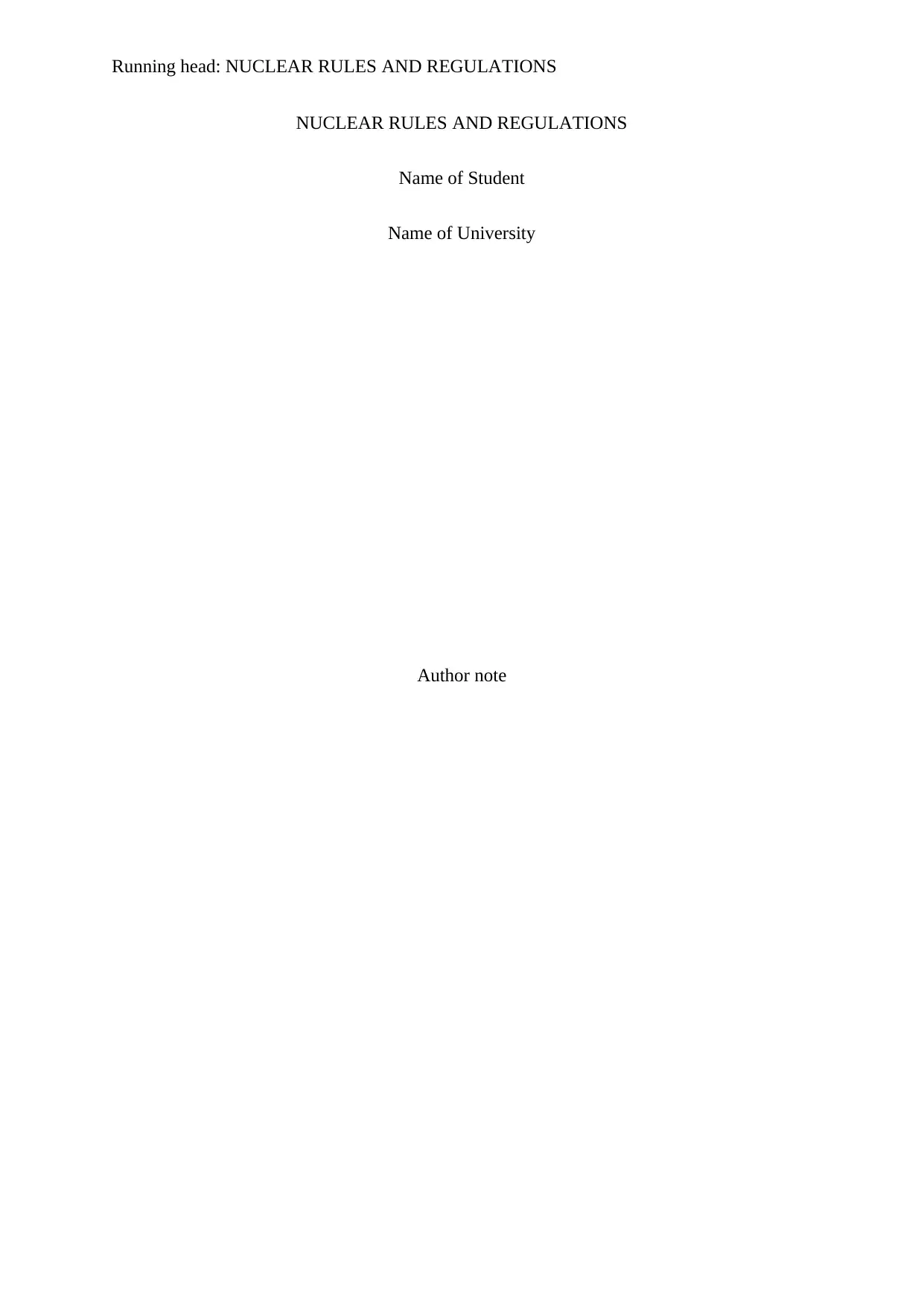
Running head: NUCLEAR RULES AND REGULATIONS
NUCLEAR RULES AND REGULATIONS
Name of Student
Name of University
Author note
NUCLEAR RULES AND REGULATIONS
Name of Student
Name of University
Author note
Paraphrase This Document
Need a fresh take? Get an instant paraphrase of this document with our AI Paraphraser
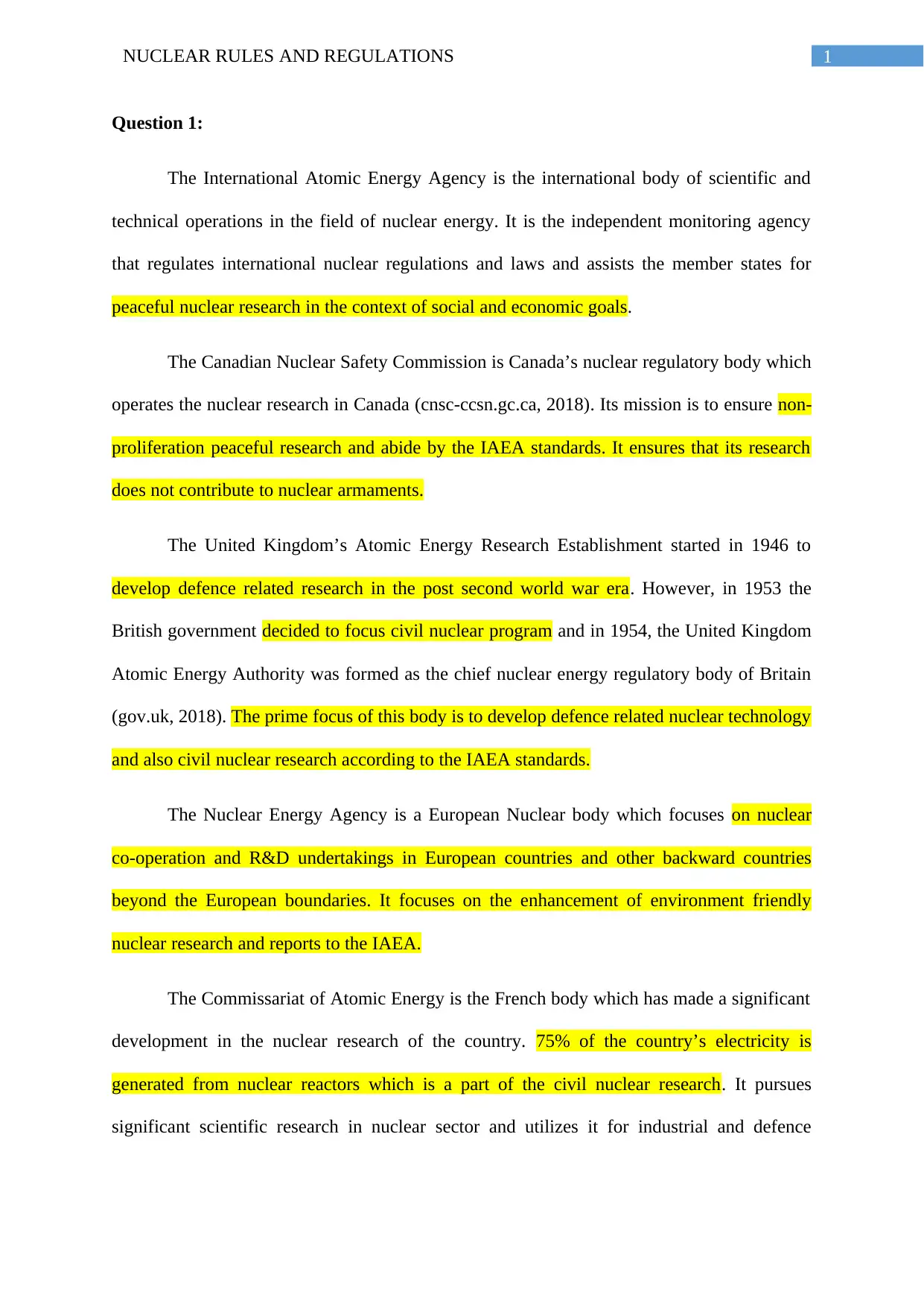
1NUCLEAR RULES AND REGULATIONS
Question 1:
The International Atomic Energy Agency is the international body of scientific and
technical operations in the field of nuclear energy. It is the independent monitoring agency
that regulates international nuclear regulations and laws and assists the member states for
peaceful nuclear research in the context of social and economic goals.
The Canadian Nuclear Safety Commission is Canada’s nuclear regulatory body which
operates the nuclear research in Canada (cnsc-ccsn.gc.ca, 2018). Its mission is to ensure non-
proliferation peaceful research and abide by the IAEA standards. It ensures that its research
does not contribute to nuclear armaments.
The United Kingdom’s Atomic Energy Research Establishment started in 1946 to
develop defence related research in the post second world war era. However, in 1953 the
British government decided to focus civil nuclear program and in 1954, the United Kingdom
Atomic Energy Authority was formed as the chief nuclear energy regulatory body of Britain
(gov.uk, 2018). The prime focus of this body is to develop defence related nuclear technology
and also civil nuclear research according to the IAEA standards.
The Nuclear Energy Agency is a European Nuclear body which focuses on nuclear
co-operation and R&D undertakings in European countries and other backward countries
beyond the European boundaries. It focuses on the enhancement of environment friendly
nuclear research and reports to the IAEA.
The Commissariat of Atomic Energy is the French body which has made a significant
development in the nuclear research of the country. 75% of the country’s electricity is
generated from nuclear reactors which is a part of the civil nuclear research. It pursues
significant scientific research in nuclear sector and utilizes it for industrial and defence
Question 1:
The International Atomic Energy Agency is the international body of scientific and
technical operations in the field of nuclear energy. It is the independent monitoring agency
that regulates international nuclear regulations and laws and assists the member states for
peaceful nuclear research in the context of social and economic goals.
The Canadian Nuclear Safety Commission is Canada’s nuclear regulatory body which
operates the nuclear research in Canada (cnsc-ccsn.gc.ca, 2018). Its mission is to ensure non-
proliferation peaceful research and abide by the IAEA standards. It ensures that its research
does not contribute to nuclear armaments.
The United Kingdom’s Atomic Energy Research Establishment started in 1946 to
develop defence related research in the post second world war era. However, in 1953 the
British government decided to focus civil nuclear program and in 1954, the United Kingdom
Atomic Energy Authority was formed as the chief nuclear energy regulatory body of Britain
(gov.uk, 2018). The prime focus of this body is to develop defence related nuclear technology
and also civil nuclear research according to the IAEA standards.
The Nuclear Energy Agency is a European Nuclear body which focuses on nuclear
co-operation and R&D undertakings in European countries and other backward countries
beyond the European boundaries. It focuses on the enhancement of environment friendly
nuclear research and reports to the IAEA.
The Commissariat of Atomic Energy is the French body which has made a significant
development in the nuclear research of the country. 75% of the country’s electricity is
generated from nuclear reactors which is a part of the civil nuclear research. It pursues
significant scientific research in nuclear sector and utilizes it for industrial and defence
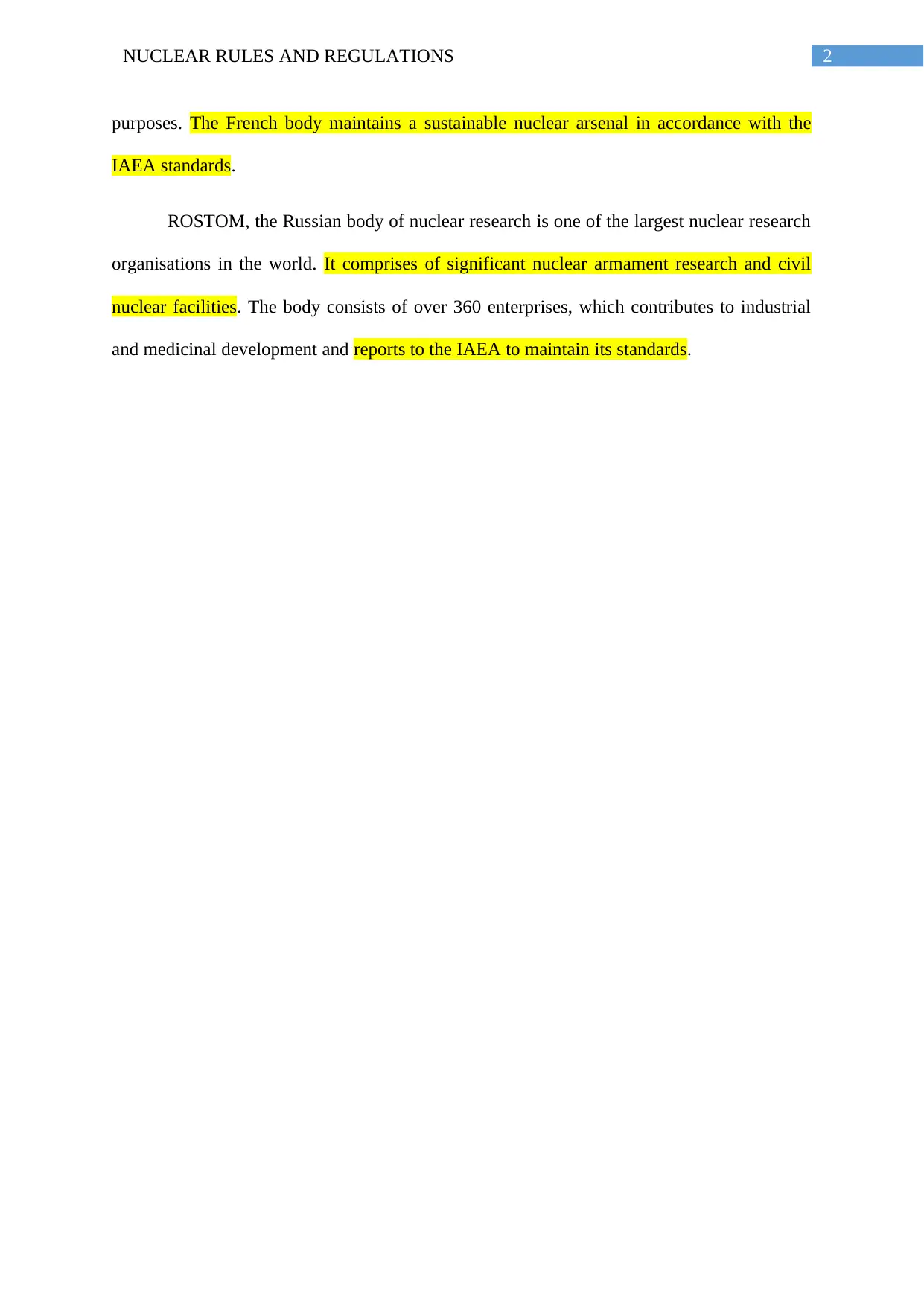
2NUCLEAR RULES AND REGULATIONS
purposes. The French body maintains a sustainable nuclear arsenal in accordance with the
IAEA standards.
ROSTOM, the Russian body of nuclear research is one of the largest nuclear research
organisations in the world. It comprises of significant nuclear armament research and civil
nuclear facilities. The body consists of over 360 enterprises, which contributes to industrial
and medicinal development and reports to the IAEA to maintain its standards.
purposes. The French body maintains a sustainable nuclear arsenal in accordance with the
IAEA standards.
ROSTOM, the Russian body of nuclear research is one of the largest nuclear research
organisations in the world. It comprises of significant nuclear armament research and civil
nuclear facilities. The body consists of over 360 enterprises, which contributes to industrial
and medicinal development and reports to the IAEA to maintain its standards.
⊘ This is a preview!⊘
Do you want full access?
Subscribe today to unlock all pages.

Trusted by 1+ million students worldwide
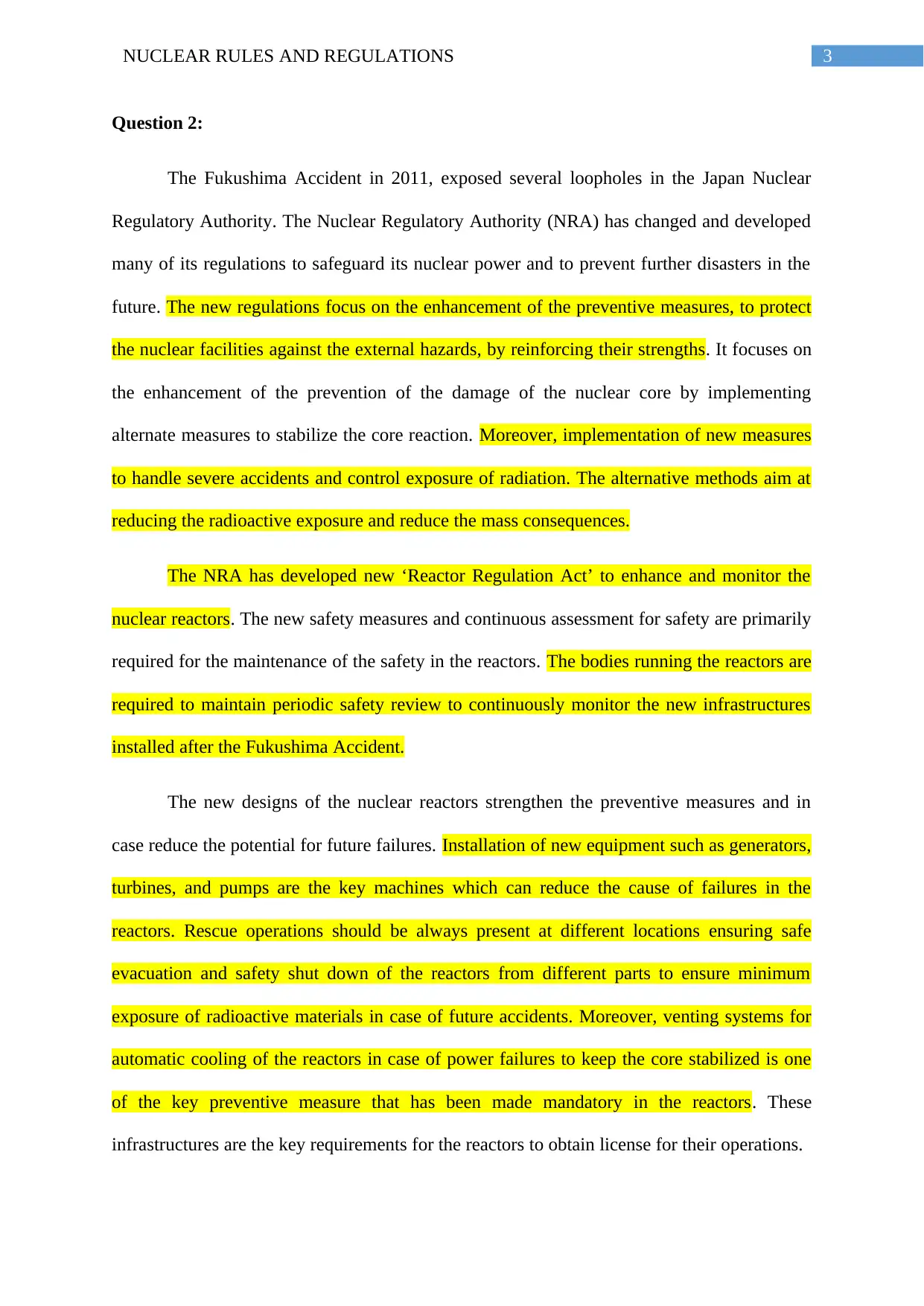
3NUCLEAR RULES AND REGULATIONS
Question 2:
The Fukushima Accident in 2011, exposed several loopholes in the Japan Nuclear
Regulatory Authority. The Nuclear Regulatory Authority (NRA) has changed and developed
many of its regulations to safeguard its nuclear power and to prevent further disasters in the
future. The new regulations focus on the enhancement of the preventive measures, to protect
the nuclear facilities against the external hazards, by reinforcing their strengths. It focuses on
the enhancement of the prevention of the damage of the nuclear core by implementing
alternate measures to stabilize the core reaction. Moreover, implementation of new measures
to handle severe accidents and control exposure of radiation. The alternative methods aim at
reducing the radioactive exposure and reduce the mass consequences.
The NRA has developed new ‘Reactor Regulation Act’ to enhance and monitor the
nuclear reactors. The new safety measures and continuous assessment for safety are primarily
required for the maintenance of the safety in the reactors. The bodies running the reactors are
required to maintain periodic safety review to continuously monitor the new infrastructures
installed after the Fukushima Accident.
The new designs of the nuclear reactors strengthen the preventive measures and in
case reduce the potential for future failures. Installation of new equipment such as generators,
turbines, and pumps are the key machines which can reduce the cause of failures in the
reactors. Rescue operations should be always present at different locations ensuring safe
evacuation and safety shut down of the reactors from different parts to ensure minimum
exposure of radioactive materials in case of future accidents. Moreover, venting systems for
automatic cooling of the reactors in case of power failures to keep the core stabilized is one
of the key preventive measure that has been made mandatory in the reactors. These
infrastructures are the key requirements for the reactors to obtain license for their operations.
Question 2:
The Fukushima Accident in 2011, exposed several loopholes in the Japan Nuclear
Regulatory Authority. The Nuclear Regulatory Authority (NRA) has changed and developed
many of its regulations to safeguard its nuclear power and to prevent further disasters in the
future. The new regulations focus on the enhancement of the preventive measures, to protect
the nuclear facilities against the external hazards, by reinforcing their strengths. It focuses on
the enhancement of the prevention of the damage of the nuclear core by implementing
alternate measures to stabilize the core reaction. Moreover, implementation of new measures
to handle severe accidents and control exposure of radiation. The alternative methods aim at
reducing the radioactive exposure and reduce the mass consequences.
The NRA has developed new ‘Reactor Regulation Act’ to enhance and monitor the
nuclear reactors. The new safety measures and continuous assessment for safety are primarily
required for the maintenance of the safety in the reactors. The bodies running the reactors are
required to maintain periodic safety review to continuously monitor the new infrastructures
installed after the Fukushima Accident.
The new designs of the nuclear reactors strengthen the preventive measures and in
case reduce the potential for future failures. Installation of new equipment such as generators,
turbines, and pumps are the key machines which can reduce the cause of failures in the
reactors. Rescue operations should be always present at different locations ensuring safe
evacuation and safety shut down of the reactors from different parts to ensure minimum
exposure of radioactive materials in case of future accidents. Moreover, venting systems for
automatic cooling of the reactors in case of power failures to keep the core stabilized is one
of the key preventive measure that has been made mandatory in the reactors. These
infrastructures are the key requirements for the reactors to obtain license for their operations.
Paraphrase This Document
Need a fresh take? Get an instant paraphrase of this document with our AI Paraphraser
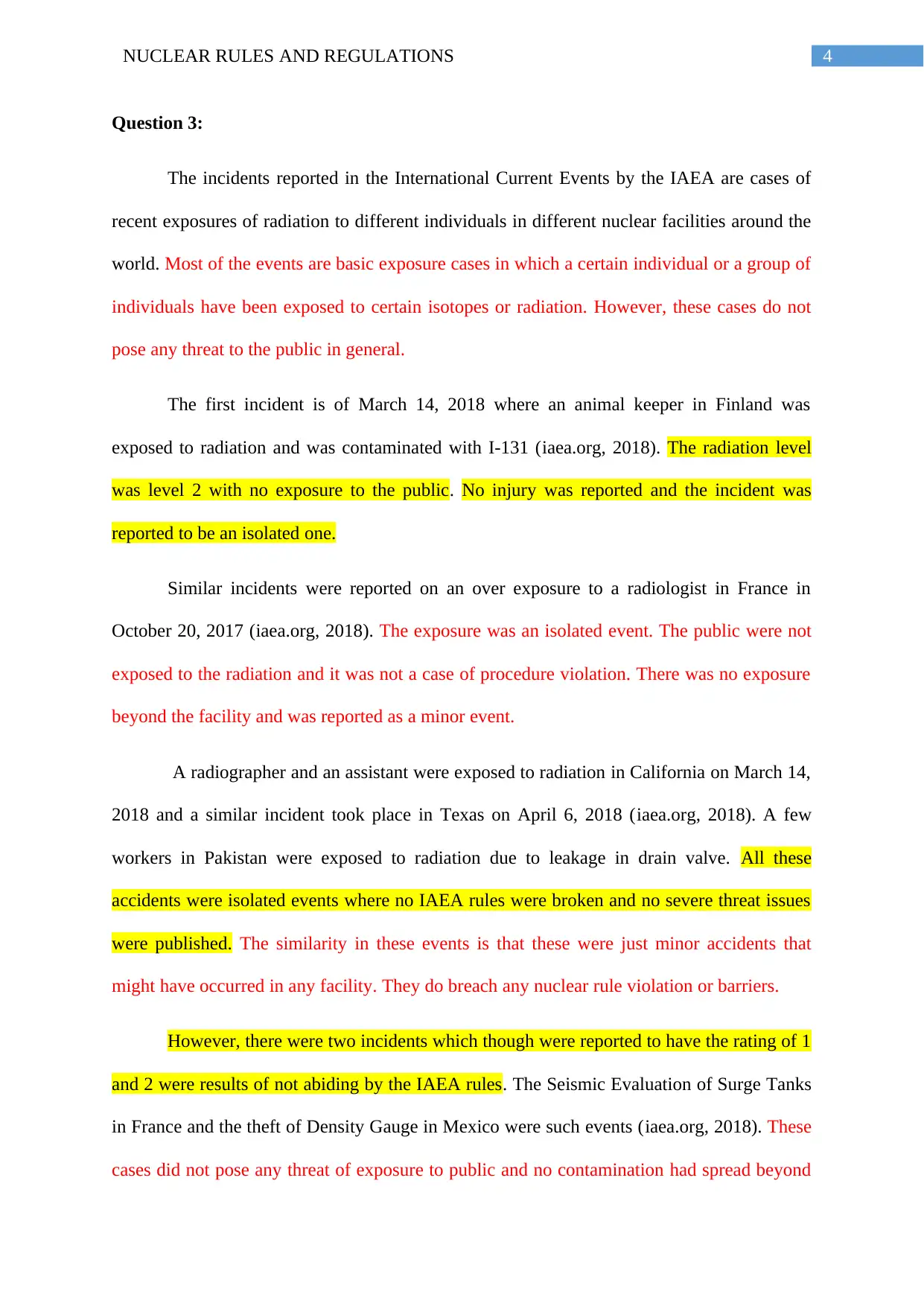
4NUCLEAR RULES AND REGULATIONS
Question 3:
The incidents reported in the International Current Events by the IAEA are cases of
recent exposures of radiation to different individuals in different nuclear facilities around the
world. Most of the events are basic exposure cases in which a certain individual or a group of
individuals have been exposed to certain isotopes or radiation. However, these cases do not
pose any threat to the public in general.
The first incident is of March 14, 2018 where an animal keeper in Finland was
exposed to radiation and was contaminated with I-131 (iaea.org, 2018). The radiation level
was level 2 with no exposure to the public. No injury was reported and the incident was
reported to be an isolated one.
Similar incidents were reported on an over exposure to a radiologist in France in
October 20, 2017 (iaea.org, 2018). The exposure was an isolated event. The public were not
exposed to the radiation and it was not a case of procedure violation. There was no exposure
beyond the facility and was reported as a minor event.
A radiographer and an assistant were exposed to radiation in California on March 14,
2018 and a similar incident took place in Texas on April 6, 2018 (iaea.org, 2018). A few
workers in Pakistan were exposed to radiation due to leakage in drain valve. All these
accidents were isolated events where no IAEA rules were broken and no severe threat issues
were published. The similarity in these events is that these were just minor accidents that
might have occurred in any facility. They do breach any nuclear rule violation or barriers.
However, there were two incidents which though were reported to have the rating of 1
and 2 were results of not abiding by the IAEA rules. The Seismic Evaluation of Surge Tanks
in France and the theft of Density Gauge in Mexico were such events (iaea.org, 2018). These
cases did not pose any threat of exposure to public and no contamination had spread beyond
Question 3:
The incidents reported in the International Current Events by the IAEA are cases of
recent exposures of radiation to different individuals in different nuclear facilities around the
world. Most of the events are basic exposure cases in which a certain individual or a group of
individuals have been exposed to certain isotopes or radiation. However, these cases do not
pose any threat to the public in general.
The first incident is of March 14, 2018 where an animal keeper in Finland was
exposed to radiation and was contaminated with I-131 (iaea.org, 2018). The radiation level
was level 2 with no exposure to the public. No injury was reported and the incident was
reported to be an isolated one.
Similar incidents were reported on an over exposure to a radiologist in France in
October 20, 2017 (iaea.org, 2018). The exposure was an isolated event. The public were not
exposed to the radiation and it was not a case of procedure violation. There was no exposure
beyond the facility and was reported as a minor event.
A radiographer and an assistant were exposed to radiation in California on March 14,
2018 and a similar incident took place in Texas on April 6, 2018 (iaea.org, 2018). A few
workers in Pakistan were exposed to radiation due to leakage in drain valve. All these
accidents were isolated events where no IAEA rules were broken and no severe threat issues
were published. The similarity in these events is that these were just minor accidents that
might have occurred in any facility. They do breach any nuclear rule violation or barriers.
However, there were two incidents which though were reported to have the rating of 1
and 2 were results of not abiding by the IAEA rules. The Seismic Evaluation of Surge Tanks
in France and the theft of Density Gauge in Mexico were such events (iaea.org, 2018). These
cases did not pose any threat of exposure to public and no contamination had spread beyond
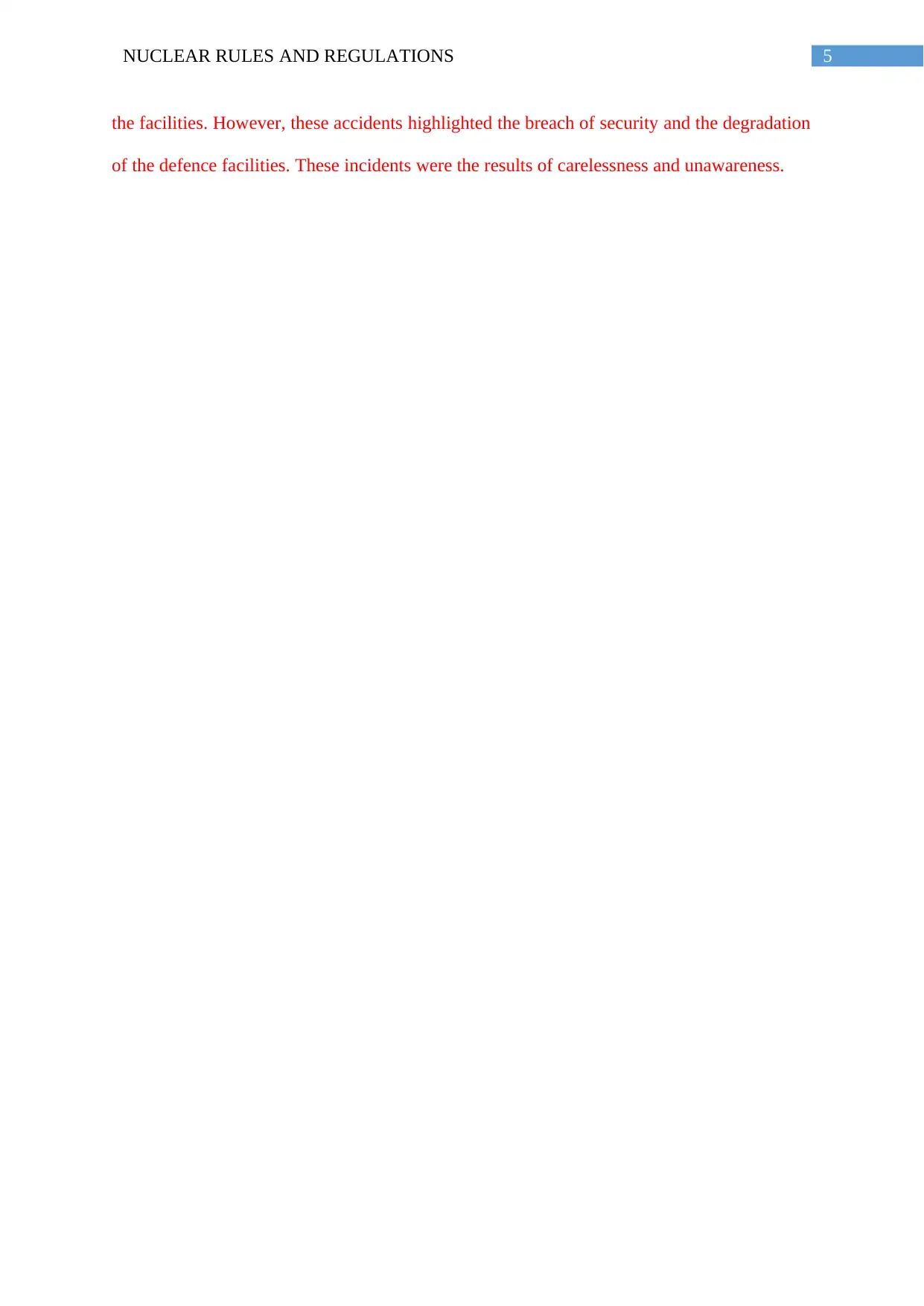
5NUCLEAR RULES AND REGULATIONS
the facilities. However, these accidents highlighted the breach of security and the degradation
of the defence facilities. These incidents were the results of carelessness and unawareness.
the facilities. However, these accidents highlighted the breach of security and the degradation
of the defence facilities. These incidents were the results of carelessness and unawareness.
⊘ This is a preview!⊘
Do you want full access?
Subscribe today to unlock all pages.

Trusted by 1+ million students worldwide
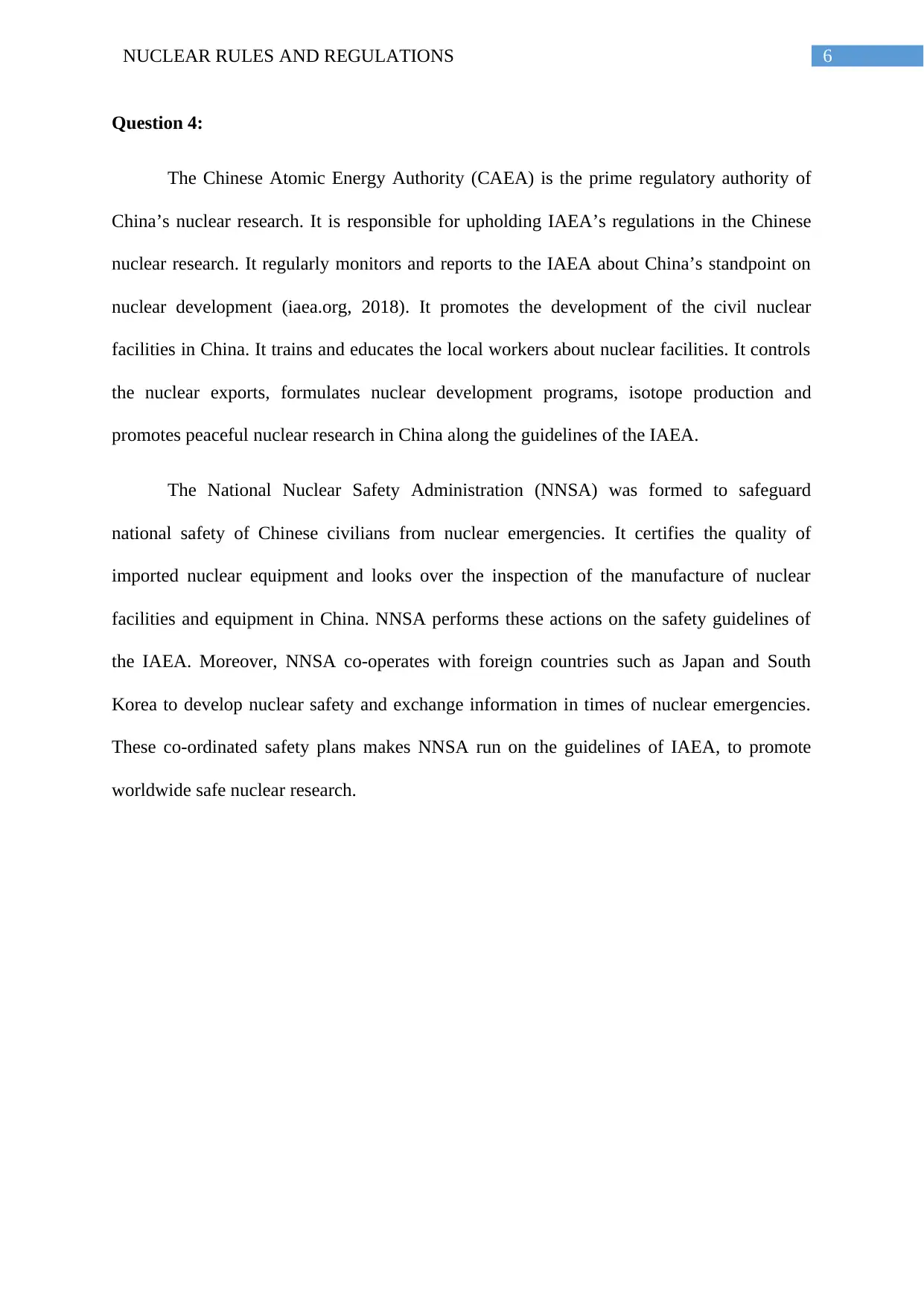
6NUCLEAR RULES AND REGULATIONS
Question 4:
The Chinese Atomic Energy Authority (CAEA) is the prime regulatory authority of
China’s nuclear research. It is responsible for upholding IAEA’s regulations in the Chinese
nuclear research. It regularly monitors and reports to the IAEA about China’s standpoint on
nuclear development (iaea.org, 2018). It promotes the development of the civil nuclear
facilities in China. It trains and educates the local workers about nuclear facilities. It controls
the nuclear exports, formulates nuclear development programs, isotope production and
promotes peaceful nuclear research in China along the guidelines of the IAEA.
The National Nuclear Safety Administration (NNSA) was formed to safeguard
national safety of Chinese civilians from nuclear emergencies. It certifies the quality of
imported nuclear equipment and looks over the inspection of the manufacture of nuclear
facilities and equipment in China. NNSA performs these actions on the safety guidelines of
the IAEA. Moreover, NNSA co-operates with foreign countries such as Japan and South
Korea to develop nuclear safety and exchange information in times of nuclear emergencies.
These co-ordinated safety plans makes NNSA run on the guidelines of IAEA, to promote
worldwide safe nuclear research.
Question 4:
The Chinese Atomic Energy Authority (CAEA) is the prime regulatory authority of
China’s nuclear research. It is responsible for upholding IAEA’s regulations in the Chinese
nuclear research. It regularly monitors and reports to the IAEA about China’s standpoint on
nuclear development (iaea.org, 2018). It promotes the development of the civil nuclear
facilities in China. It trains and educates the local workers about nuclear facilities. It controls
the nuclear exports, formulates nuclear development programs, isotope production and
promotes peaceful nuclear research in China along the guidelines of the IAEA.
The National Nuclear Safety Administration (NNSA) was formed to safeguard
national safety of Chinese civilians from nuclear emergencies. It certifies the quality of
imported nuclear equipment and looks over the inspection of the manufacture of nuclear
facilities and equipment in China. NNSA performs these actions on the safety guidelines of
the IAEA. Moreover, NNSA co-operates with foreign countries such as Japan and South
Korea to develop nuclear safety and exchange information in times of nuclear emergencies.
These co-ordinated safety plans makes NNSA run on the guidelines of IAEA, to promote
worldwide safe nuclear research.
Paraphrase This Document
Need a fresh take? Get an instant paraphrase of this document with our AI Paraphraser
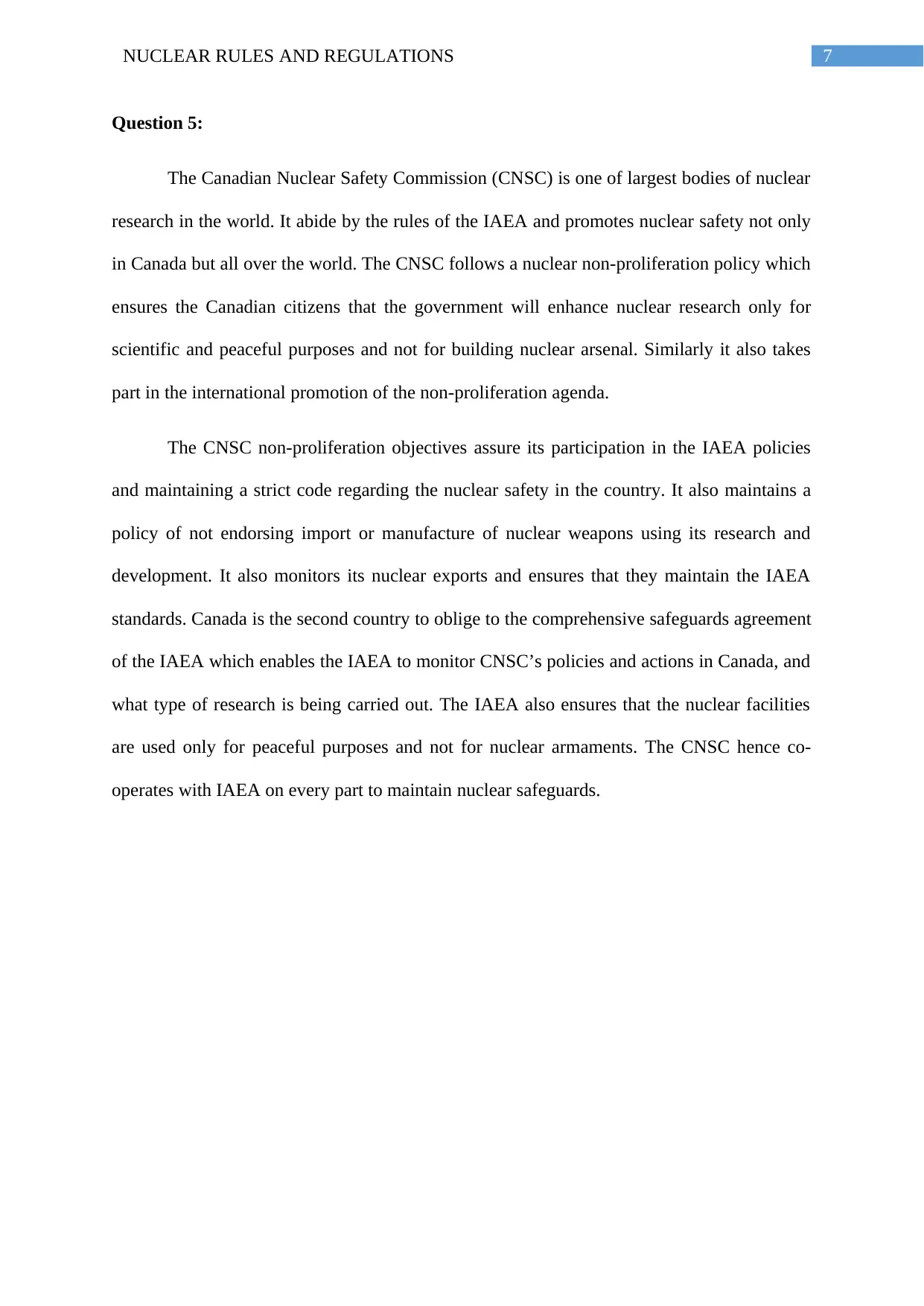
7NUCLEAR RULES AND REGULATIONS
Question 5:
The Canadian Nuclear Safety Commission (CNSC) is one of largest bodies of nuclear
research in the world. It abide by the rules of the IAEA and promotes nuclear safety not only
in Canada but all over the world. The CNSC follows a nuclear non-proliferation policy which
ensures the Canadian citizens that the government will enhance nuclear research only for
scientific and peaceful purposes and not for building nuclear arsenal. Similarly it also takes
part in the international promotion of the non-proliferation agenda.
The CNSC non-proliferation objectives assure its participation in the IAEA policies
and maintaining a strict code regarding the nuclear safety in the country. It also maintains a
policy of not endorsing import or manufacture of nuclear weapons using its research and
development. It also monitors its nuclear exports and ensures that they maintain the IAEA
standards. Canada is the second country to oblige to the comprehensive safeguards agreement
of the IAEA which enables the IAEA to monitor CNSC’s policies and actions in Canada, and
what type of research is being carried out. The IAEA also ensures that the nuclear facilities
are used only for peaceful purposes and not for nuclear armaments. The CNSC hence co-
operates with IAEA on every part to maintain nuclear safeguards.
Question 5:
The Canadian Nuclear Safety Commission (CNSC) is one of largest bodies of nuclear
research in the world. It abide by the rules of the IAEA and promotes nuclear safety not only
in Canada but all over the world. The CNSC follows a nuclear non-proliferation policy which
ensures the Canadian citizens that the government will enhance nuclear research only for
scientific and peaceful purposes and not for building nuclear arsenal. Similarly it also takes
part in the international promotion of the non-proliferation agenda.
The CNSC non-proliferation objectives assure its participation in the IAEA policies
and maintaining a strict code regarding the nuclear safety in the country. It also maintains a
policy of not endorsing import or manufacture of nuclear weapons using its research and
development. It also monitors its nuclear exports and ensures that they maintain the IAEA
standards. Canada is the second country to oblige to the comprehensive safeguards agreement
of the IAEA which enables the IAEA to monitor CNSC’s policies and actions in Canada, and
what type of research is being carried out. The IAEA also ensures that the nuclear facilities
are used only for peaceful purposes and not for nuclear armaments. The CNSC hence co-
operates with IAEA on every part to maintain nuclear safeguards.
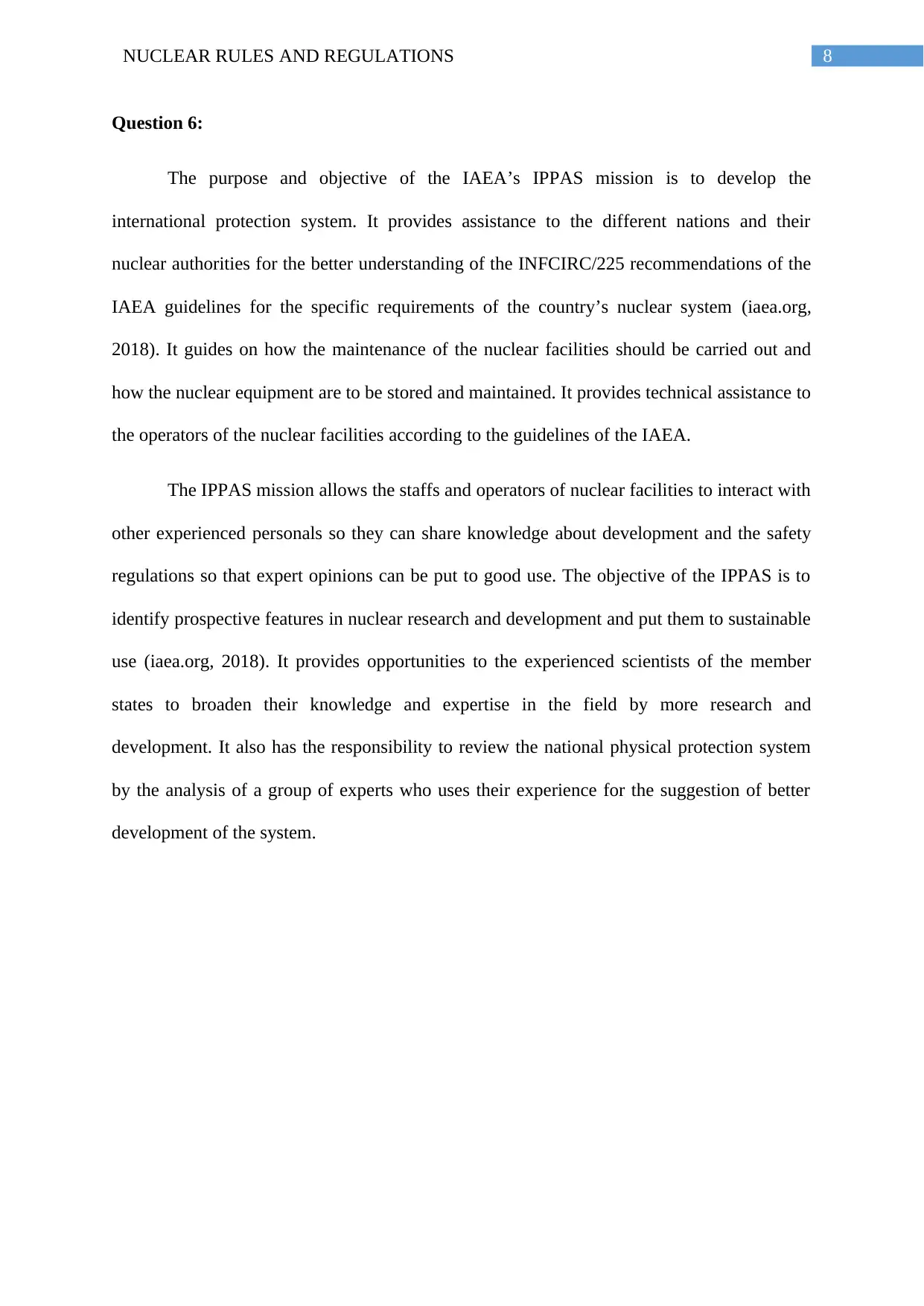
8NUCLEAR RULES AND REGULATIONS
Question 6:
The purpose and objective of the IAEA’s IPPAS mission is to develop the
international protection system. It provides assistance to the different nations and their
nuclear authorities for the better understanding of the INFCIRC/225 recommendations of the
IAEA guidelines for the specific requirements of the country’s nuclear system (iaea.org,
2018). It guides on how the maintenance of the nuclear facilities should be carried out and
how the nuclear equipment are to be stored and maintained. It provides technical assistance to
the operators of the nuclear facilities according to the guidelines of the IAEA.
The IPPAS mission allows the staffs and operators of nuclear facilities to interact with
other experienced personals so they can share knowledge about development and the safety
regulations so that expert opinions can be put to good use. The objective of the IPPAS is to
identify prospective features in nuclear research and development and put them to sustainable
use (iaea.org, 2018). It provides opportunities to the experienced scientists of the member
states to broaden their knowledge and expertise in the field by more research and
development. It also has the responsibility to review the national physical protection system
by the analysis of a group of experts who uses their experience for the suggestion of better
development of the system.
Question 6:
The purpose and objective of the IAEA’s IPPAS mission is to develop the
international protection system. It provides assistance to the different nations and their
nuclear authorities for the better understanding of the INFCIRC/225 recommendations of the
IAEA guidelines for the specific requirements of the country’s nuclear system (iaea.org,
2018). It guides on how the maintenance of the nuclear facilities should be carried out and
how the nuclear equipment are to be stored and maintained. It provides technical assistance to
the operators of the nuclear facilities according to the guidelines of the IAEA.
The IPPAS mission allows the staffs and operators of nuclear facilities to interact with
other experienced personals so they can share knowledge about development and the safety
regulations so that expert opinions can be put to good use. The objective of the IPPAS is to
identify prospective features in nuclear research and development and put them to sustainable
use (iaea.org, 2018). It provides opportunities to the experienced scientists of the member
states to broaden their knowledge and expertise in the field by more research and
development. It also has the responsibility to review the national physical protection system
by the analysis of a group of experts who uses their experience for the suggestion of better
development of the system.
⊘ This is a preview!⊘
Do you want full access?
Subscribe today to unlock all pages.

Trusted by 1+ million students worldwide
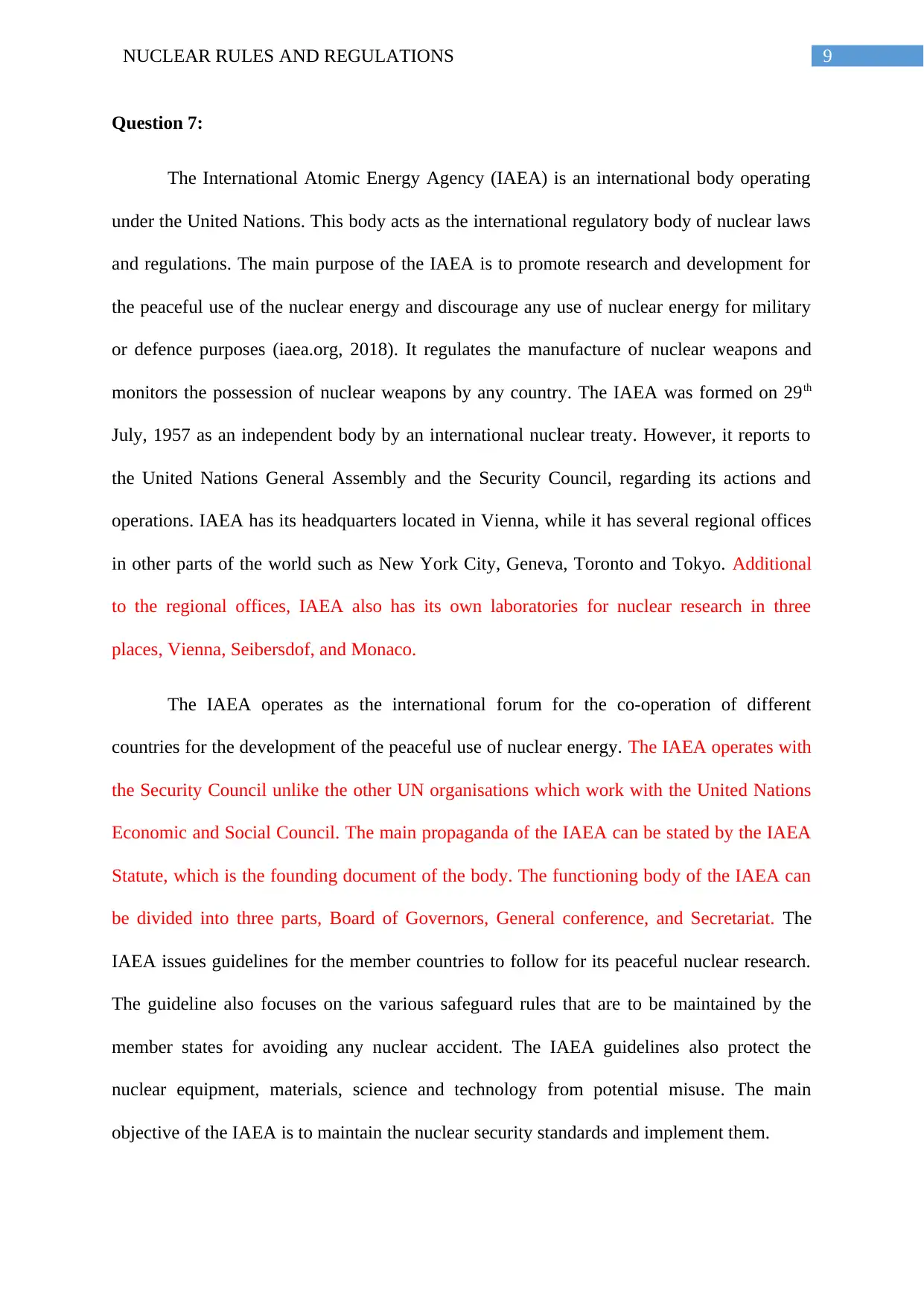
9NUCLEAR RULES AND REGULATIONS
Question 7:
The International Atomic Energy Agency (IAEA) is an international body operating
under the United Nations. This body acts as the international regulatory body of nuclear laws
and regulations. The main purpose of the IAEA is to promote research and development for
the peaceful use of the nuclear energy and discourage any use of nuclear energy for military
or defence purposes (iaea.org, 2018). It regulates the manufacture of nuclear weapons and
monitors the possession of nuclear weapons by any country. The IAEA was formed on 29th
July, 1957 as an independent body by an international nuclear treaty. However, it reports to
the United Nations General Assembly and the Security Council, regarding its actions and
operations. IAEA has its headquarters located in Vienna, while it has several regional offices
in other parts of the world such as New York City, Geneva, Toronto and Tokyo. Additional
to the regional offices, IAEA also has its own laboratories for nuclear research in three
places, Vienna, Seibersdof, and Monaco.
The IAEA operates as the international forum for the co-operation of different
countries for the development of the peaceful use of nuclear energy. The IAEA operates with
the Security Council unlike the other UN organisations which work with the United Nations
Economic and Social Council. The main propaganda of the IAEA can be stated by the IAEA
Statute, which is the founding document of the body. The functioning body of the IAEA can
be divided into three parts, Board of Governors, General conference, and Secretariat. The
IAEA issues guidelines for the member countries to follow for its peaceful nuclear research.
The guideline also focuses on the various safeguard rules that are to be maintained by the
member states for avoiding any nuclear accident. The IAEA guidelines also protect the
nuclear equipment, materials, science and technology from potential misuse. The main
objective of the IAEA is to maintain the nuclear security standards and implement them.
Question 7:
The International Atomic Energy Agency (IAEA) is an international body operating
under the United Nations. This body acts as the international regulatory body of nuclear laws
and regulations. The main purpose of the IAEA is to promote research and development for
the peaceful use of the nuclear energy and discourage any use of nuclear energy for military
or defence purposes (iaea.org, 2018). It regulates the manufacture of nuclear weapons and
monitors the possession of nuclear weapons by any country. The IAEA was formed on 29th
July, 1957 as an independent body by an international nuclear treaty. However, it reports to
the United Nations General Assembly and the Security Council, regarding its actions and
operations. IAEA has its headquarters located in Vienna, while it has several regional offices
in other parts of the world such as New York City, Geneva, Toronto and Tokyo. Additional
to the regional offices, IAEA also has its own laboratories for nuclear research in three
places, Vienna, Seibersdof, and Monaco.
The IAEA operates as the international forum for the co-operation of different
countries for the development of the peaceful use of nuclear energy. The IAEA operates with
the Security Council unlike the other UN organisations which work with the United Nations
Economic and Social Council. The main propaganda of the IAEA can be stated by the IAEA
Statute, which is the founding document of the body. The functioning body of the IAEA can
be divided into three parts, Board of Governors, General conference, and Secretariat. The
IAEA issues guidelines for the member countries to follow for its peaceful nuclear research.
The guideline also focuses on the various safeguard rules that are to be maintained by the
member states for avoiding any nuclear accident. The IAEA guidelines also protect the
nuclear equipment, materials, science and technology from potential misuse. The main
objective of the IAEA is to maintain the nuclear security standards and implement them.
Paraphrase This Document
Need a fresh take? Get an instant paraphrase of this document with our AI Paraphraser
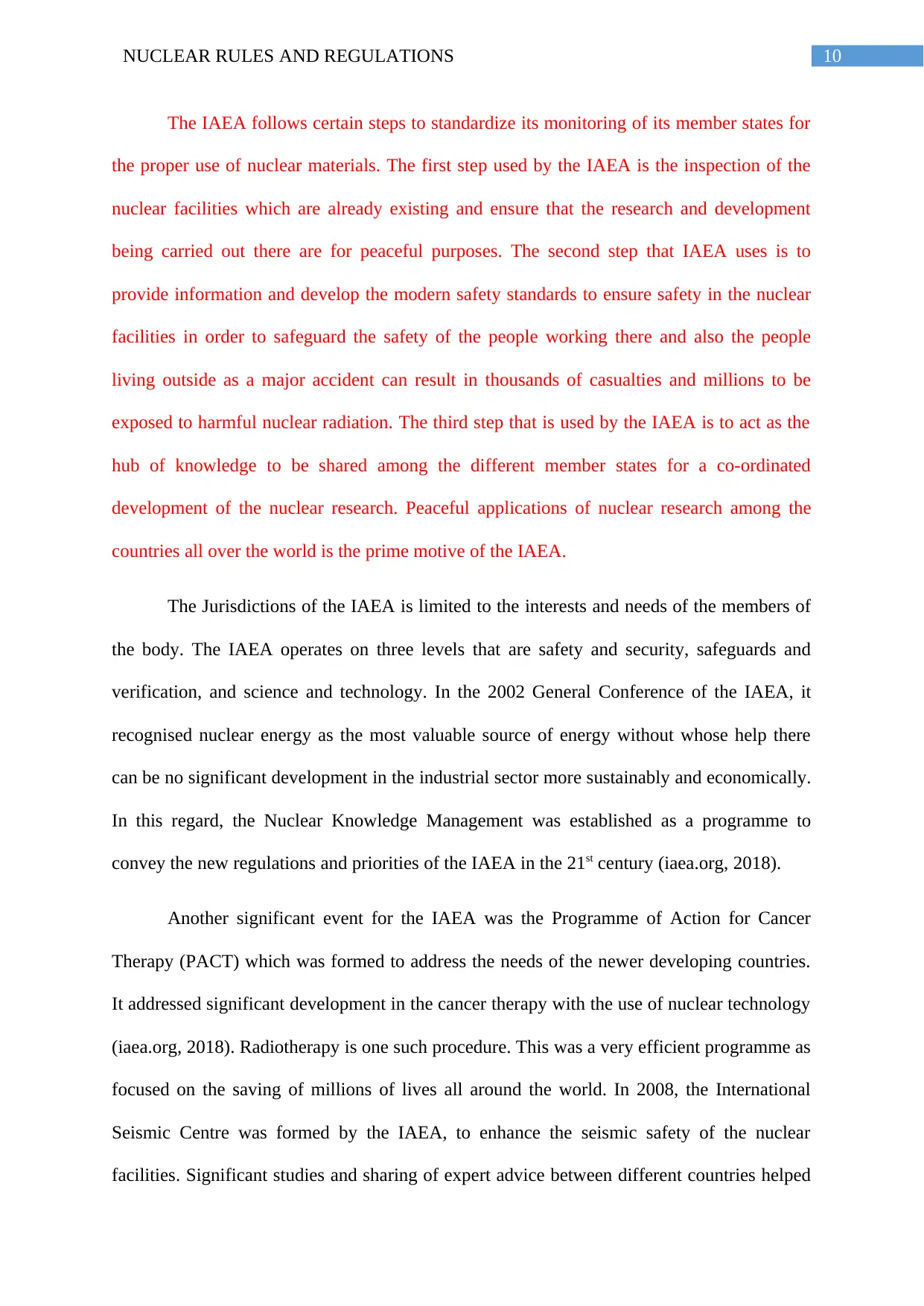
10NUCLEAR RULES AND REGULATIONS
The IAEA follows certain steps to standardize its monitoring of its member states for
the proper use of nuclear materials. The first step used by the IAEA is the inspection of the
nuclear facilities which are already existing and ensure that the research and development
being carried out there are for peaceful purposes. The second step that IAEA uses is to
provide information and develop the modern safety standards to ensure safety in the nuclear
facilities in order to safeguard the safety of the people working there and also the people
living outside as a major accident can result in thousands of casualties and millions to be
exposed to harmful nuclear radiation. The third step that is used by the IAEA is to act as the
hub of knowledge to be shared among the different member states for a co-ordinated
development of the nuclear research. Peaceful applications of nuclear research among the
countries all over the world is the prime motive of the IAEA.
The Jurisdictions of the IAEA is limited to the interests and needs of the members of
the body. The IAEA operates on three levels that are safety and security, safeguards and
verification, and science and technology. In the 2002 General Conference of the IAEA, it
recognised nuclear energy as the most valuable source of energy without whose help there
can be no significant development in the industrial sector more sustainably and economically.
In this regard, the Nuclear Knowledge Management was established as a programme to
convey the new regulations and priorities of the IAEA in the 21st century (iaea.org, 2018).
Another significant event for the IAEA was the Programme of Action for Cancer
Therapy (PACT) which was formed to address the needs of the newer developing countries.
It addressed significant development in the cancer therapy with the use of nuclear technology
(iaea.org, 2018). Radiotherapy is one such procedure. This was a very efficient programme as
focused on the saving of millions of lives all around the world. In 2008, the International
Seismic Centre was formed by the IAEA, to enhance the seismic safety of the nuclear
facilities. Significant studies and sharing of expert advice between different countries helped
The IAEA follows certain steps to standardize its monitoring of its member states for
the proper use of nuclear materials. The first step used by the IAEA is the inspection of the
nuclear facilities which are already existing and ensure that the research and development
being carried out there are for peaceful purposes. The second step that IAEA uses is to
provide information and develop the modern safety standards to ensure safety in the nuclear
facilities in order to safeguard the safety of the people working there and also the people
living outside as a major accident can result in thousands of casualties and millions to be
exposed to harmful nuclear radiation. The third step that is used by the IAEA is to act as the
hub of knowledge to be shared among the different member states for a co-ordinated
development of the nuclear research. Peaceful applications of nuclear research among the
countries all over the world is the prime motive of the IAEA.
The Jurisdictions of the IAEA is limited to the interests and needs of the members of
the body. The IAEA operates on three levels that are safety and security, safeguards and
verification, and science and technology. In the 2002 General Conference of the IAEA, it
recognised nuclear energy as the most valuable source of energy without whose help there
can be no significant development in the industrial sector more sustainably and economically.
In this regard, the Nuclear Knowledge Management was established as a programme to
convey the new regulations and priorities of the IAEA in the 21st century (iaea.org, 2018).
Another significant event for the IAEA was the Programme of Action for Cancer
Therapy (PACT) which was formed to address the needs of the newer developing countries.
It addressed significant development in the cancer therapy with the use of nuclear technology
(iaea.org, 2018). Radiotherapy is one such procedure. This was a very efficient programme as
focused on the saving of millions of lives all around the world. In 2008, the International
Seismic Centre was formed by the IAEA, to enhance the seismic safety of the nuclear
facilities. Significant studies and sharing of expert advice between different countries helped
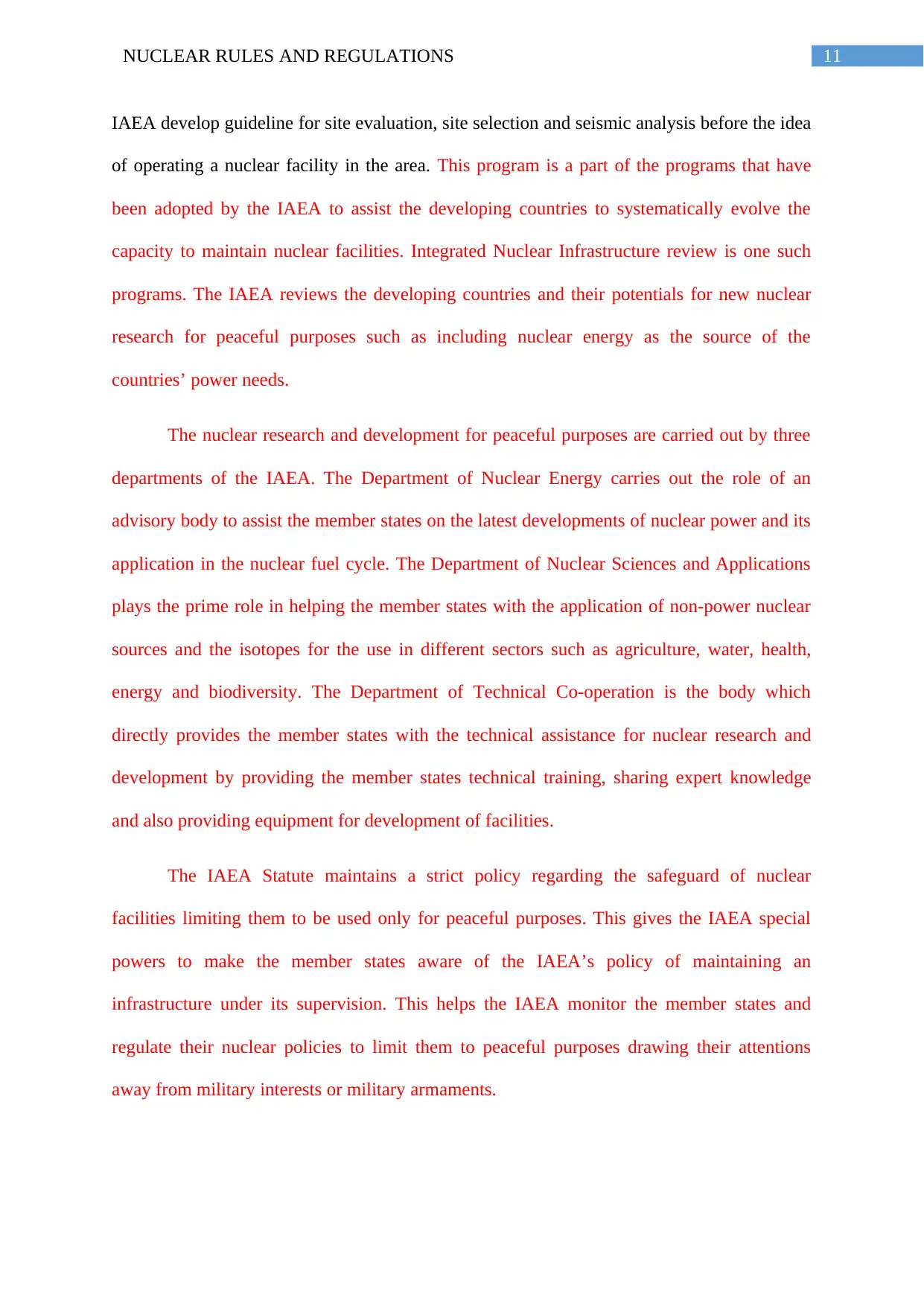
11NUCLEAR RULES AND REGULATIONS
IAEA develop guideline for site evaluation, site selection and seismic analysis before the idea
of operating a nuclear facility in the area. This program is a part of the programs that have
been adopted by the IAEA to assist the developing countries to systematically evolve the
capacity to maintain nuclear facilities. Integrated Nuclear Infrastructure review is one such
programs. The IAEA reviews the developing countries and their potentials for new nuclear
research for peaceful purposes such as including nuclear energy as the source of the
countries’ power needs.
The nuclear research and development for peaceful purposes are carried out by three
departments of the IAEA. The Department of Nuclear Energy carries out the role of an
advisory body to assist the member states on the latest developments of nuclear power and its
application in the nuclear fuel cycle. The Department of Nuclear Sciences and Applications
plays the prime role in helping the member states with the application of non-power nuclear
sources and the isotopes for the use in different sectors such as agriculture, water, health,
energy and biodiversity. The Department of Technical Co-operation is the body which
directly provides the member states with the technical assistance for nuclear research and
development by providing the member states technical training, sharing expert knowledge
and also providing equipment for development of facilities.
The IAEA Statute maintains a strict policy regarding the safeguard of nuclear
facilities limiting them to be used only for peaceful purposes. This gives the IAEA special
powers to make the member states aware of the IAEA’s policy of maintaining an
infrastructure under its supervision. This helps the IAEA monitor the member states and
regulate their nuclear policies to limit them to peaceful purposes drawing their attentions
away from military interests or military armaments.
IAEA develop guideline for site evaluation, site selection and seismic analysis before the idea
of operating a nuclear facility in the area. This program is a part of the programs that have
been adopted by the IAEA to assist the developing countries to systematically evolve the
capacity to maintain nuclear facilities. Integrated Nuclear Infrastructure review is one such
programs. The IAEA reviews the developing countries and their potentials for new nuclear
research for peaceful purposes such as including nuclear energy as the source of the
countries’ power needs.
The nuclear research and development for peaceful purposes are carried out by three
departments of the IAEA. The Department of Nuclear Energy carries out the role of an
advisory body to assist the member states on the latest developments of nuclear power and its
application in the nuclear fuel cycle. The Department of Nuclear Sciences and Applications
plays the prime role in helping the member states with the application of non-power nuclear
sources and the isotopes for the use in different sectors such as agriculture, water, health,
energy and biodiversity. The Department of Technical Co-operation is the body which
directly provides the member states with the technical assistance for nuclear research and
development by providing the member states technical training, sharing expert knowledge
and also providing equipment for development of facilities.
The IAEA Statute maintains a strict policy regarding the safeguard of nuclear
facilities limiting them to be used only for peaceful purposes. This gives the IAEA special
powers to make the member states aware of the IAEA’s policy of maintaining an
infrastructure under its supervision. This helps the IAEA monitor the member states and
regulate their nuclear policies to limit them to peaceful purposes drawing their attentions
away from military interests or military armaments.
⊘ This is a preview!⊘
Do you want full access?
Subscribe today to unlock all pages.

Trusted by 1+ million students worldwide
1 out of 14
Your All-in-One AI-Powered Toolkit for Academic Success.
+13062052269
info@desklib.com
Available 24*7 on WhatsApp / Email
![[object Object]](/_next/static/media/star-bottom.7253800d.svg)
Unlock your academic potential
Copyright © 2020–2025 A2Z Services. All Rights Reserved. Developed and managed by ZUCOL.